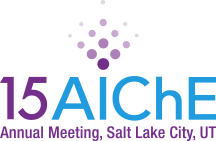

Scale-up of Amine-Containing Membranes for CO2 Capture and Separation
Witopo Salim1, Varun Vakharia1, Dongzhu Wu1, Yuanxin Chen1, Lin Zhao1, Yang Han1, and W.S. Winston Ho1,2
1William G. Lowrie Department of Chemical and Biomolecular Engineering, The Ohio State University, 151 West Woodruff Avenue, Columbus, OH 43210-1180, USA
2Department of Materials Science and Engineering, The Ohio State University, 2041 College Road, Columbus, OH 43210-1178, USA
Abstract
Amine-containing membranes for CO2 capture and separation were scaled up to fabricate 14-inch wide membranes by using a continuous roll-to-roll machine equipped with a thin-film-coating assembly. Aided by a material balance equation, three variables, including the coating knife gap setting, substrate rolling speed, and coating solution concentration, were identified as the critical factors to control the membrane selective layer thickness. For the CO2 separation from a synthesis gas stream containing CO2 and H2S, i.e., pre-combustion CO2 capture in IGCC (integrated gasification combined cycle) technology or hydrogen purification for fuel cells, the thicker amine-containing membranes with around 15 ± 2 microns of selective layer thicknesses were fabricated by using a gap setting of 17 mils, a rolling speed of 0.5 ft/min (set by the drying capacity of the drier, i.e., its length), and an amine coating solution of 18 wt%. For the post-combustion CO2 capture from flue gas, the same thin-film-coating assembly machine was used to fabricate thinner amine containing membranes with < 250 ± 20 nm of selective layer thicknesses by using various rolling speeds and amine-containing solution concentrations at a fixed gap setting of 0.45 mils. The fabrication of thinner membranes was improved further by using an insert in the coating solution trough to control the coating solution delivery rate and a smooth coating knife base to reduce the thickness variation. From the gas transport measurements, the flat-sheet samples of the scale-up membranes for both applications exhibited similar performances compared to the membranes synthesized in lab scale. CO2 permeance of approximately 200 GPU and CO2/H2 selectivity > 180 for the thicker membranes for the purification of hydrogen and synthesis gas along with CO2 capture (e.g., pre-combustion capture), and CO2 permeance of about 800 GPU and CO2/N2 selectivity > 140 for the thinner membranes for CO2 capture from flue gas. Techno-economic analysis of the post-combustion CO2 capture membrane process using the thin membrane resulted in about $41/tonne CO2 captured (based on 2007 dollar). The scale-up membranes can be used to prepare pilot-scale membrane modules, either as spiral-wound or plate-and-frame configuration, for testing with the acid gas mixtures or flue gas.
